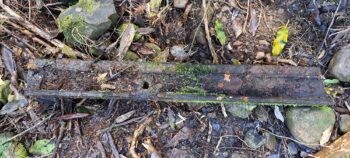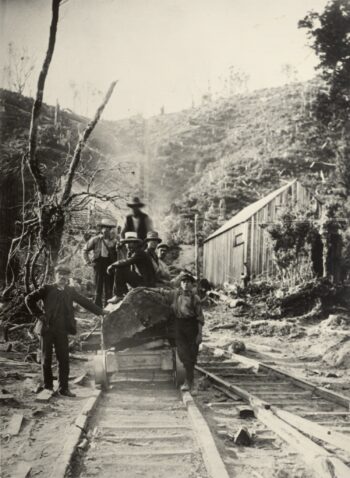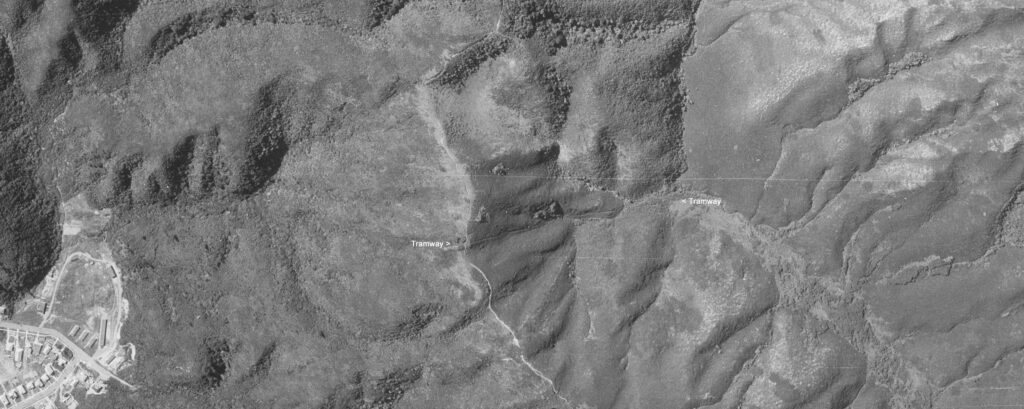Tramways in Wainuiomata were a key part of the local timber industry in the 19th and early 20th centuries.
Wainuiomata, located near Wellington, New Zealand, was heavily forested, making it an ideal location for sawmilling operations, with significant demand for timber in the rapidly growing cities of Wellington and Lower Hutt.
These tramways were narrow-gauge railways constructed to move logs from remote and rugged forested areas to sawmills. In Wainuiomata, they played a crucial role in transporting timber through challenging terrain such as valleys and ridges, areas that would have been difficult to navigate by horse-drawn wagons. Initially, the tramways had wooden rails, and the wagons were pulled by horses and bullocks. This was a common practice in New Zealand’s logging industry before the introduction of mechanized transport, as it minimised construction costs and allowed for the rapid movement of large logs.
As technology advanced, steam-powered or cable-operated systems gradually replaced horse power, particularly in areas with steep inclines or where heavier timber loads were involved. These developments improved the efficiency of logging operations and prolonged the use of tramways. Sawmills, such as those operated by companies like the Strand Brothers, were often situated near tramways, enabling logs to be processed on-site. These tramways connected the forests with the mills and linked them to local roads, from where the processed timber could be transported to markets in Wellington and beyond.
The widespread logging facilitated by these tramways had a considerable impact on Wainuiomata’s environment. Large tracts of native forest, including beech, rata, and kahikatea, were cleared to meet the demand for timber. While this logging activity contributed to the economic development of the area, it also led to the depletion of much of the region’s native bush, prompting later efforts to protect what remained.
By the mid-20th century, the use of logging tramways declined as trucks and improved road networks provided more flexible and cost-effective methods for transporting timber. The waning of native logging operations in the area also contributed to the tramways’ eventual abandonment. Today, remnants of these old tramways and logging operations can still be found in Wainuiomata, often repurposed as walking tracks in forest reserves.
Apart from the tracks and cuts in the landscape, only a few remnants of these tramways remain. These include smaller metal objects, antique bottles, partially buried cables, in Naenae and a single rail track found in the regenerating forest of Wainuiomata.
Sinclair Tramway
 The Sinclair family of Wainuiomata built a wooden tramway in Sinclair Valley which is now called Reservoir Valley. They replaced the wooden tramway with an iron tramway and once logging ceased, the tramway was used to transport people to the dam. Eventually, the tramway was replaced by Reservoir Road.
The Sinclair family of Wainuiomata built a wooden tramway in Sinclair Valley which is now called Reservoir Valley. They replaced the wooden tramway with an iron tramway and once logging ceased, the tramway was used to transport people to the dam. Eventually, the tramway was replaced by Reservoir Road.
Strand Brothers Tramway
 Around 1907, stretching into the 1910s, the Strand Brothers undertook the ambitious construction and operation of a tramway from Naenae that crossed the ridge into upper Moores Valley in Wainuiomata. Unlike the Sinclair Tramway, this was a different operation, as it navigated a steep hill, with the mill, winch, and log-hauling camp all linked by telephone. The brothers were astonished by both the quality and the quantity of trees still standing in this part of Wainuiomata.
Around 1907, stretching into the 1910s, the Strand Brothers undertook the ambitious construction and operation of a tramway from Naenae that crossed the ridge into upper Moores Valley in Wainuiomata. Unlike the Sinclair Tramway, this was a different operation, as it navigated a steep hill, with the mill, winch, and log-hauling camp all linked by telephone. The brothers were astonished by both the quality and the quantity of trees still standing in this part of Wainuiomata.


